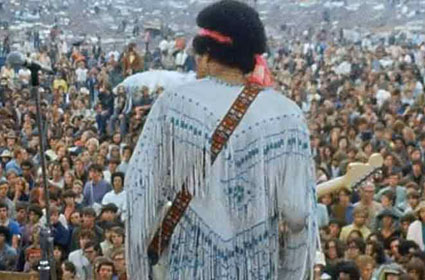Originally published March 24, 2016 | Link to original
Dear Friend and Reader:
There is an astrological event brewing that happens this spring for the first time since 1927: a conjunction of two slow-moving outer planets called Uranus and Eris. You may recall that Eris became famous in 2006 when it precipitated the re-definition of a planet, leading to the ‘demotion’ of Pluto.

What is so exciting is that because Eris was discovered just 11 years ago, we will experience this conjunction with full awareness for the first time in human history.
We’ve seen the Uranus-Eris conjunction coming for years; and the association between what these planets represent, and how society is changing, seems pretty clear if you know what to look for.
Yet before we dive into a distinctly modern astrological technique of assessing an outer-planet event for the entire culture and for each of us as individuals, I would like to start with a point of history.
By 1965, the birth contractions of what would become “the Sixties” were already happening. I use 1965 as a reference point since it’s the year of an astrological event associated with everything that happened in that era — the most potent conjunction prior to what we’re experiencing now.
In August 1963, for example, the March on Washington for Jobs and Freedom announced a new phase in the civil rights struggle that began in the mid-1950s. That was where Martin Luther King, Jr. delivered his “I Have a Dream” speech before an in-person audience of about 250,000 people, most of them African American. Later in 1963, a young Pres. John F. Kennedy was assassinated in Dallas.
Just 12 weeks later, the Beatles arrived in New York, creating a sensation like the world had never seen. The Free Speech movement erupted in Berkeley. By summer 1964, the Vietnam War was officially underway when Congress passed the Tonkin Gulf Resolution. These things were, of course, just the beginning. Everything was changing, and was changing fast, and going in directions that nobody could predict.

The pace of unprecedented events would accelerate clear through the murders of MLK and Robert Kennedy, the election of Richard Nixon in 1968, and his resignation in 1973.
Woodstock, widespread use of LSD, the Moon landing, the shootings at Kent State University, national campus protests, the first flight of the 747 and the Concorde, revelations and leaps forward in all of the arts, in literature, in technology and in religion: the Sixties were a distinct, strange, tragic, wild and beautiful time, comparable to nothing before them. It’s true that there were similarly revolutionary eras in history, but the addition of mass culture, of technology and in particular of coverage in the media sets the Sixties apart from anything that happened before.
Most astrologers who are working today know that there was a rare planetary event associated with the Sixties, called the Uranus-Pluto conjunction. It happens less than once per century, and the event of 1965 and 1966 took place in Virgo.
Both Pluto and Uranus had been discovered by that time, and their positions were available to anyone who sought out the information. Uranus was discovered in 1781 and Pluto was discovered in 1930. They were hardly late-breaking news in 1965, decades or centuries after discovery. Yet this was the first-ever conjunction between them that anyone alive had lived through consciously.
I’ve always wondered whether astrologers who were working in the 1960s had any idea that the conjunction was happening, and if they did, whether they worked with it consciously. I had my doubts.

The first person to ask was Robert Hand. Many people know of Rob from his most famous book, Planets in Transit. Having accomplished many things since that writing, including earning a Ph.D. in the history of astrology (at the Catholic University of America, of all places) and co-founding what is today a full-on classical astrology revival, Rob is considered the dean of American astrology.
So I called him last week to find out whether the astrology profession was aware of Uranus conjunct Pluto while it was happening. He said he started attending astrology groups in 1962, and that people were not talking about it in the grassroots organizations where he had the most contact. Astrology was, at the time, in its nascent form; the practice of astrology had not yet become as popular as it would become (in part with the help of Uranus-Pluto).
There were no books about Pluto available in English (one had been written in German but was not translated till the 1970s; a pamphlet came out in the late 1970s and the first book in English finally came out in the early 1980s). So people didn’t have a lot of readily available information to work with and felt they didn’t really grasp it. However, this may only have applied to the people Hand was actually encountering in the astrology groups he attended early in his career.
I asked Richard Tarnas, author of Prometheus the Awakener, The Passion of the Western Mind and Cosmos and Psyche, the same question. He came to astrology in the mid-1970s and was not personally present in the community during the Sixties to answer directly from experience, though he pointed out two things.
One is that a number of the more advanced writers were developing ideas about Pluto in journal articles, which were at the time an important source of information for people studying astrology. Those writers included the American astrologer Dane Rudhyar and the British astrologer Charles Harvey. So we know there were sources of information on Pluto if people knew where to look for them.

“I’m sure many astrologers were aware of the Uranus-Pluto conjunction having some relationship to the events of the 1960s. Though it seems to have been generally with a more limited temporal focus, centered more on the 1965-66 period, without quite recognizing the larger waveform extending throughout the decade.”
In other words, they didn’t understand that an event that technically lasted nine months in 1965-66 would have an influence spanning over 10 to 12 years. That method of inquiry was developed by Tarnas himself, who is one of the leading scholars on the historic effects of outer planet transit events. For an excellent introduction to that mode of astrology, by the way, I recommend Prometheus the Awakener, which is short, sweet and action-packed. And it’s easy to follow as well.
Of course, all any curious astrologer needed to do was to look at the world. You know, step away from the desk and take in all that was going down, then look back at the chart for something similarly unprecedented. But it wasn’t until after the conjunction was over and the Sixties had already had their impact that anyone really made the connection.
We might ask why it would have mattered. I think it’s useful to seek an understanding of astrology while it’s happening (we do a lot of it in this column). The job of astrologers is to guide people to expanded awareness, and to help point out opportunities. That often means living out the astrology in real time with full awareness.
Astrology can help us understand themes as well as point to potential places for growth. I don’t know if the Sixties would have been any different had astrologers understood what was happening. What I do know is that today, we are approaching an event of even greater proportions. Planets seem to gain influence by moving more slowly. It takes Eris more than twice as long as Pluto to orbit the Sun.

Yet it makes more sense to say that we live in times that are described perfectly by the known themes of Eris — chaos and discord, to name two of the more obvious (but surface layer) ones. This is a special kind of chaos, however, coming partly from within ourselves and energized by our environment.
One somewhat humorous contrast between the Sixties and today is that the Sixties were about boldly finding out who you were at any cost. Today, we practice a kind of cultivated cluelessness about identity, leading to some real difficulty with any notion of ‘I am’ that to me is very much reflective of Eris in Aries as a psychological factor.
Then there is the subversive quality of Eris. It seems the only way to get anything done these days is either to spend millions of dollars, or to go underground, or to hack the system in some way and subvert the dominant paradigm. There is no such thing as legitimate anymore. If there is, it’s not particularly useful. Today, rules are made to be violated.
Yet there’s much more than that. The world seems to be seething on the edge of a boiling point, or a critical-mass point. Anger is building, for example, visible as rage and violence at Donald Trump rallies. Billionaires are born daily while most people struggle to make ends meet. People are starting to figure out that they’re getting ripped off, and are done holding their anger inside. Black Lives Matter has emerged in response to what can be described as a prolonged, state-sponsored killing spree of young, unarmed black men.
Bernie Sanders has demonstrated that there is an equally vital well of idealism and goodwill in the American psyche. Many of us have been fretting over the Citizens’ United ruling of the Supreme Court, which granted corporations unlimited rights to donate money to political causes.
Yet all the billionaires in the land have not been able to match the millions of $25 donations arriving from Sanders supporters. If nothing else, Bernie is proving one thing: You don’t need a super PAC to wage an expensive presidential campaign. The money is flowing up to Bernie, not down to him. This is not the same as an authentic grassroots movement, but it’s a lot closer than the Koch brothers writing million-dollar checks.

The Sanders campaign and the Trump campaign have two things in common. One is that they are based on populist movements. The other is that they are both subverting the power structure of the mainstream political parties.
Today the Republicans who sold their souls to the Tea Party are considered the old guard. That’s funny, but it’s rendered hilarious because they are struggling to contain the very monster that they unleashed.
They are scrambling to get a grip; for example, devoting an entire edition of the uber-conservative National Review to the topic of how to deal with Trump. How quaint is that? It’s the modern equivalent of bringing a knife to a gunfight: responding to something driven by the Internet with some well-proofread, neatly typeset magazine articles. Who even knew?
Which leads me to another key point of the current zeitgeist: nobody seems to have a gosh-darned clue what’s going on. Nobody seems to understand the Internet, especially the people who claim to be the experts. By far the very most clueless-to-the-point-of-vertigo people I’ve ever met, when it comes to the Internet, are Internet marketing specialists. Save yourself the $1500 retainer fee most of them charge, take your kid out to get ice cream, and go over any questions you have.
If we look to Uranus-Eris for some guidance, the place the Internet has had its greatest impact is on self-concept. Our entire notion of what it means to be a self has been run through the digital blender. The most pressing question about the Internet is not what it is, or how it works, but what it’s made people into. Every definition of self and relationship has changed radically in the 20 years we’ve been living with the commercial ‘net, and in the seven or so years since nearly everyone has felt compelled to have a ‘smart’ phone running their life.

You might think Twitter is ridiculous, but you might ask yourself how much longer than 140 characters your attention span really holds up. What was the last book you read? How much of it do you remember?
The Uranus-Eris conjunction seems balanced on a delicate edge. To one side is a raging ocean of narcissism and superficiality. It’s as if the glow of the iPhone or Android screen is a glamour (in the original sense, a kind of spell) that draws people in, charming them into submission, never to let them go. Uranus, representing groups and technology, will likely drive this even further. All new media shape the predominant sense of self. New electronic media tend to cause implosions of the psyche rather than expansions. They collapse space and time, in theory bring everyone ‘closer’ but in reality pulling people deeper into a new kind of inner chaos, which feels like a new kind of high.
To the other side is a potential wave of awakening, of self-awareness, of seeking individuation. The force of Eris that seems to be provoking identity chaos can also have a kind of homeopathic effect of precipitating self-actualization. Uranus, which also represents a kind of shocking, revolutionary inner-awareness, can also bring in large groups of people working with similar ideas.
The thing missing seems to be a central organizing principle. Amidst all the chaos and mixed emotions, it’s not easy to find the golden thread. I have an idea what it is.
Before Uranus makes its first conjunction to Eris in Aries on June 9, something else happens involving Aries: Mars stations retrograde. Every two years, the Earth passes between Mars and the Sun, which makes Mars appear to move backward through the zodiac. I will open this subject here and continue in future columns; though let’s say that Mars retrograde will provide, I think, an excellent point of focus.
Mars will begin its retrograde in spiritually centered Sagittarius, and end the retrograde in sexually and emotionally focused Scorpio. It will do this between April 17 and June 29.

Here’s my idea of the golden thread: what you think of as spiritual is really about sex. This is not my original idea, but I could easily claim it, since nobody seems to remember. Carl Jung suggested this; Wilhelm Reich wrote his most important book about it. The mystical longing (as Reich called it) is the direct product of sexual frustration.
Spirituality (especially in its more persistent, purist, politically correct form) is the product of the sex drive. What, exactly, could be more spiritual than the very thing that creates new life?
The problem is that the corporate owner of God has deemed sex in nearly every form a sin, guaranteeing itself nearly perpetual business (along with a child sex trafficking business that has cost the Church more than $3 billion in damages payouts — more money than any person can actually imagine, paid by a church that spends most of its time preaching purity and chasity).
Mars retrograde will do something inherently tantric: it will seek the underlying sexual nature of all existence. Between April 18 and June 28, Mars will swim upstream from Sagittarius, seeking to spawn in the headwaters of its own sign, Scorpio. Borrowing a line from Bono, religion stole sex from us — and now it’s time for us to steal it back.
To be continued next week.
Lovingly,




